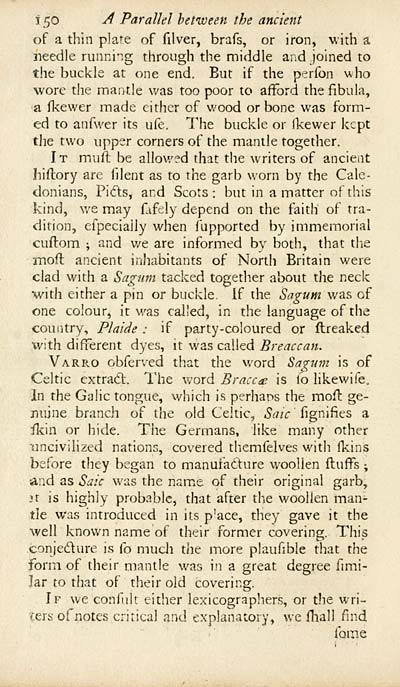Blair Collection > Critical dissertations on the origin, antiquities, language, government, manners, and religion, of the antient Caledonians, their posterity the Picts, and the British and Irish Scots
(188)
Download files
Complete book:
Individual page:
Thumbnail gallery: Grid view | List view

i 50 A Parallel between the ancient
of a thin pla'ie of filver, brafs, or iron, with a
needle runnng through the middle and joined to
the buckle at one end. But if the perfon uho
wore the mantle was too poor to afford the fibula,
a fkewer made either of wood or bone was form-
ed to anfwer its ufe. The buckle or Ikewer kept
the two upper corners of the mantle together.
It muft be allov.^ed that the writers of ancient
hiftory are filent as to the garb worn by the Cale-
donians, Pi<fls, and Scots: but in a matter of this
kind, we may GfV^ly depend on the faith of tra-
dition, efpecially when fupported by immemorial
cuftom ; and v/e are informed by both, that the
moll ancient inhabitants of North Britain were
clad with a Sagnm tacked together about the neck
•with either a pin or buckle. If the Sagum was of
one colour, it was called, in the language of the
country, Plaicie : if party-coloured or ftreaked
with different dyes, it was called Breaccan.
Varro obferved that the word Sagum is of
Celtic extratt. The word Braccte is lo likewife.
In the Galic tongue, which is perhans the mofl ge-
nuine branch of the old Celtic, Saic fignifies a
il^in or hide. The Germans, like many other
■uncivilized nations, covered themfelves with fkins
before they began to manufacture woollen fluffs ;
and as Saic was the name of their original garb,
jt is highly probable, that after the woollen man-
tle was introduced in its p'ace, they gave it the
well known name of their former covering. This
conjedure is fo much the more plaufible that the
form of their mantle was in a great degree fimi-
lar to that of their old covering.
If we confiilt either lexicograpliers, or the wri-
ters of notes critical and explanatory, we fhall find
Tome
of a thin pla'ie of filver, brafs, or iron, with a
needle runnng through the middle and joined to
the buckle at one end. But if the perfon uho
wore the mantle was too poor to afford the fibula,
a fkewer made either of wood or bone was form-
ed to anfwer its ufe. The buckle or Ikewer kept
the two upper corners of the mantle together.
It muft be allov.^ed that the writers of ancient
hiftory are filent as to the garb worn by the Cale-
donians, Pi<fls, and Scots: but in a matter of this
kind, we may GfV^ly depend on the faith of tra-
dition, efpecially when fupported by immemorial
cuftom ; and v/e are informed by both, that the
moll ancient inhabitants of North Britain were
clad with a Sagnm tacked together about the neck
•with either a pin or buckle. If the Sagum was of
one colour, it was called, in the language of the
country, Plaicie : if party-coloured or ftreaked
with different dyes, it was called Breaccan.
Varro obferved that the word Sagum is of
Celtic extratt. The word Braccte is lo likewife.
In the Galic tongue, which is perhans the mofl ge-
nuine branch of the old Celtic, Saic fignifies a
il^in or hide. The Germans, like many other
■uncivilized nations, covered themfelves with fkins
before they began to manufacture woollen fluffs ;
and as Saic was the name of their original garb,
jt is highly probable, that after the woollen man-
tle was introduced in its p'ace, they gave it the
well known name of their former covering. This
conjedure is fo much the more plaufible that the
form of their mantle was in a great degree fimi-
lar to that of their old covering.
If we confiilt either lexicograpliers, or the wri-
ters of notes critical and explanatory, we fhall find
Tome
Set display mode to: Large image | Transcription
Images and transcriptions on this page, including medium image downloads, may be used under the Creative Commons Attribution 4.0 International Licence unless otherwise stated. ![]()
| Permanent URL | https://digital.nls.uk/76288679 |
|---|
| Description | A selection of books from a collection of more than 500 titles, mostly on religious and literary topics. Also includes some material dealing with other Celtic languages and societies. Collection created towards the end of the 19th century by Lady Evelyn Stewart Murray. |
|---|
| Description | Selected items from five 'Special and Named Printed Collections'. Includes books in Gaelic and other Celtic languages, works about the Gaels, their languages, literature, culture and history. |
|---|

